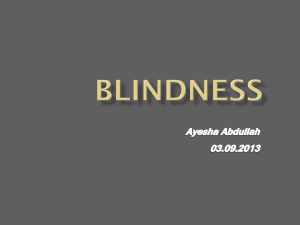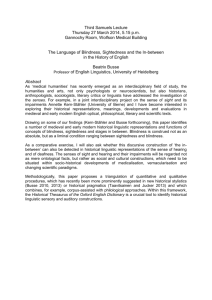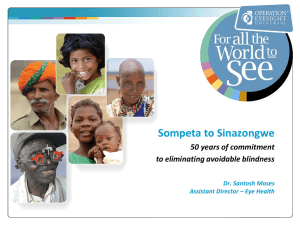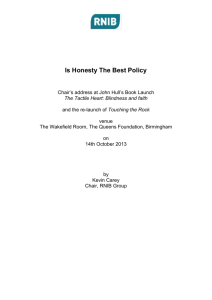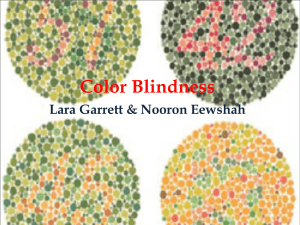Maria Meehan PhD, Research Manager, Fighting
advertisement
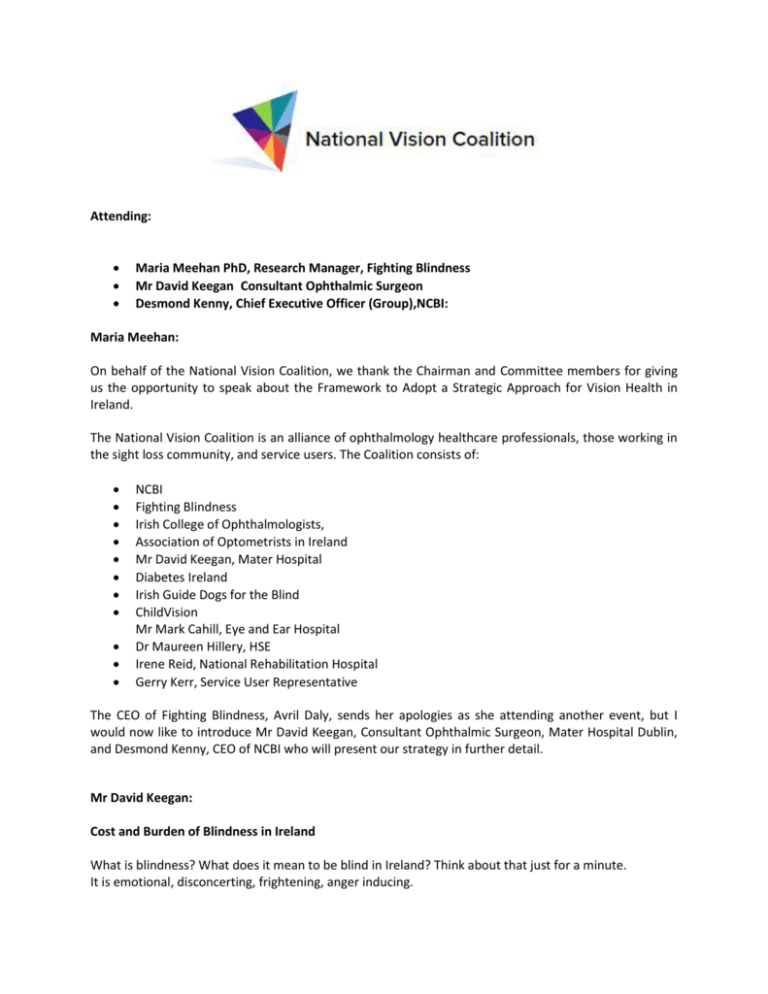
Attending: Maria Meehan PhD, Research Manager, Fighting Blindness Mr David Keegan, Consultant Ophthalmic Surgeon Desmond Kenny, Chief Executive Officer (Group),NCBI: Maria Meehan: On behalf of the National Vision Coalition, we thank the Chairman and Committee members for giving us the opportunity to speak about the Framework to Adopt a Strategic Approach for Vision Health in Ireland. The National Vision Coalition is an alliance of ophthalmology healthcare professionals, those working in the sight loss community, and service users. The Coalition consists of: NCBI Fighting Blindness Irish College of Ophthalmologists, Association of Optometrists in Ireland Mr David Keegan, Mater Hospital Diabetes Ireland Irish Guide Dogs for the Blind ChildVision Mr Mark Cahill, Eye and Ear Hospital Dr Maureen Hillery, HSE Irene Reid, National Rehabilitation Hospital Gerry Kerr, Service User Representative The CEO of Fighting Blindness, Avril Daly, sends her apologies as she attending another event, but I would now like to introduce Mr David Keegan, Consultant Ophthalmic Surgeon, Mater Hospital Dublin, and Desmond Kenny, CEO of NCBI who will present our strategy in further detail. Mr David Keegan: Cost and Burden of Blindness in Ireland What is blindness? What does it mean to be blind in Ireland? Think about that just for a minute. It is emotional, disconcerting, frightening, anger inducing. Why? 75% of it is preventable Blindness and Vision Loss definitions • Blindness is defined as best vision less than 10% of normal vision in the better-seeing eye. What does that mean? Struggling with all visual tasks up to total loss of sight. • Moderate vision impairment is defined as best vision just 10 - 30% vision in the better-seeing eye. What does that mean? Difficulty reading, cannot drive and performing many tasks becomes tough and problematic to perform. LESS IMMEDIACY • Mild vision impairment is defined as best vision just 30 - 50% vision in the better-seeing eye. What does this mean? cannot drive. LOSING INDEPENDENCE. Introduction One in 20 people in Ireland are affected by one of the four main eye diseases(1), cataract, age related macular degeneration, glaucoma or diabetic macular edema. Rising to 1:2 for people over the age of 80. Each individual eye disease leads to a significant reduction in wellbeing, which is equivalent to 702,000 workdays(2) lost per year or 2.1 million healthy days lost per annum(3). The financial cost of blindness and vision impairment, to the Irish State, was €386 million in 2010 and will rise at this current rate to €449 million by 2020(4). This is manifest in the: Dept of Social Protection through increased welfare payments and fewer people in the workforce. Dept of Finance, through a reduced tax take and the deadweight loss incurred by transferring monies from the tax take to the welfare side. And of course the Dept of Health through supports and interventions for patients affected by blindness and vision impairment. However, if we introduce interventions such as screening for cataracts and diabetic retinopathy and provide for other early interventions, we can ensure that for hundreds of people their sight is retained, and, we will also be saving the State hundreds of millions of euro. Rather than incurring higher costs, up to €76 million could potentially be saved if a series of costeffective measures for the four main eye diseases in Ireland were implemented(4). This does not require a significant budget increase, rather services need to be improved through efficient use of existing resources and targeted increase in resources for key areas. The burden of eye disease and preventable blindness People with vision loss are up to eight times more likely to fracture a hip, three times more likely to be depressed, and admission to nursing homes takes place up to three years earlier. Thus there is a significant financial benefit, if sight loss can be avoided. It must also be noted that the cost to the State increases significantly if a person progresses from being: visually impaired (€1,700 per person per annum)(5) to being blind (€21,000 per person per annum)(4). Preventable blindness is an Irish, European and global issue, not just a third-world issue. The National Vision Coalition is committed to tackling the issue in Ireland. Many of structures are already in place to tackle preventable blindness, but more help is needed from policymakers so that we may co-ordinate a comprehensive and cohesive approach. This can be achieved through a National Vision Strategy. Evidence of benefits of Introducing a Strategy in Ireland In Ireland we successfully introduced the Cancer Strategy in 2006 and have seen an improvement in patient survival rates, improved quality of care and we are producing globally relevant grand breaking research. The benefits of a targeted health strategy have already been seen here. Real world evidence of the benefits of preventing blindness: The results of adopting this more strategic approach can already be seen in other countries. Looking at the Danish and Scottish experience, the incidence of blindness due to age related macular degeneration (AMD: in Denmark) and diabetic retinopathy (in Scotland) has now been reduced by 50% through appropriate treatment, and similar savings could be made if Ireland adopted such a targeted approach. Diabetes complications are the leading cause of blindness among the working age population in Ireland. It has been internationally recognised that screening and treatment of diabetic retinopathy is one of the most cost-effective interventions ever investigated, preventing 6% of potential blindness in the first year of treatment(6). The recent establishment of the Diabetic Retinopathy Screening and Treatment Programme and the HSE’s National Programme for Eye Care has provided a real opportunity to achieve improved outcomes for people with sight loss in Ireland. There are approximately 147,000 diabetics on the programme register, and an estimated 4.5% (6,525) have sight-threatening retinopathy(6). The total cost of screening and treatment and sight loss costs almost €100 million under the Programme for six years (2013-2018). It will peak in years 2015 and 2016 as we identify and manage the current prevalent cases but should reduce as we deal with incident eye disease and new diabetic referrals. While the gross €100m seems high, there is only a net figure of just over €21 million (over 5 years) if you offset the cost without screening or treatment and related vision loss costs(6). That is just €145 per diabetic patient over 6 years. The programme will also prevent 235 cases of blindness, 696 cases of moderate vision impairment 1857 cases of mild vision impairment within that time span(6). For some of them it means they can stay working and continue to contribute. For others, it means they can keep their independence and live on their own or continue to drive. Our job is to look after patients at risk of, or affected by, sight loss and blindness. We are asking you to help us fulfil that role in the public interest by adoption of this coherent National Vision Strategy that pulls all the existing and proposed components of eye care together. A fully implemented strategy reducing preventable blindness will save thousands of Irish people from blindness and vision impairment and save the exchequer up to €76 Million per annum. Des Kenny: What we have given to you this morning is a summary of our framework or road map for a joined up strategy around eye health and associated support services. The coalition, on whose behalf we have presented, comprises all the people and organisations which can deliver on a strategy. The strategy can reduce to near elimination preventable blindness – 75% to 80% of deteriorating sight loss can be arrested. We can’t create that strategy but we can deliver on such a strategy. We can assure the Committee of its multiple values in savings of €76m per annum to a health service under severe financial pressure. We can assure the Committee that the strategy guarantees an improved independent lifestyle for people in their older years. As people live longer, the eye diseases of aging have to be combatted. There is no inevitability that sight loss has to darken the last years of old age. We all have relatives or we know people whose sight is “not the best”. The Vision Coalition’s framework provides for a seamless pathway to a person from their first visit to an optician to the offer to them of treatments back in their local community by optometrists and community ophthalmologists. There is only a short window of opportunity from the time of the diagnosis of eye disease to achieve a full arrest of loss of vision. If Government does not enlarge the framework to a strategy and see the road map of the coalition as leading to cost-effective services, the result will be an unnecessary and scandalous loss of eye-sight in hundreds of thousands of ageing people going into the future. When I had my childhood accident in the mid-fifties cortisone wasn’t widely available. Had it been more generally in use, I would not have been blinded also in my right eye as a result of a cross-infection with the blinding injury in my left eye. The treatments for today’s eye diseases are known and can be made more widely available at a fraction of the cost of the €76M which can be saved by the adoption of a national vision strategy. Today’s blindness is unnecessary. Where it does happen, support services such as those offered by Fighting Blindness, Guide Dogs for the Blind, Child Vision and NCBI can restore or give a new and different form of independence to people like myself. But, please, please don’t have people reach into our services unnecessarily because the state will not invest in their eye health. The coalition is comprised of organisations and bodies who are joining our efforts in making this case which we know to have the sympathy of the minister but, chair, deputies and senators, can the Committee give us more than sympathy for our cause and help us have the government deliver on a national vision strategy. Thank you. ENDS
